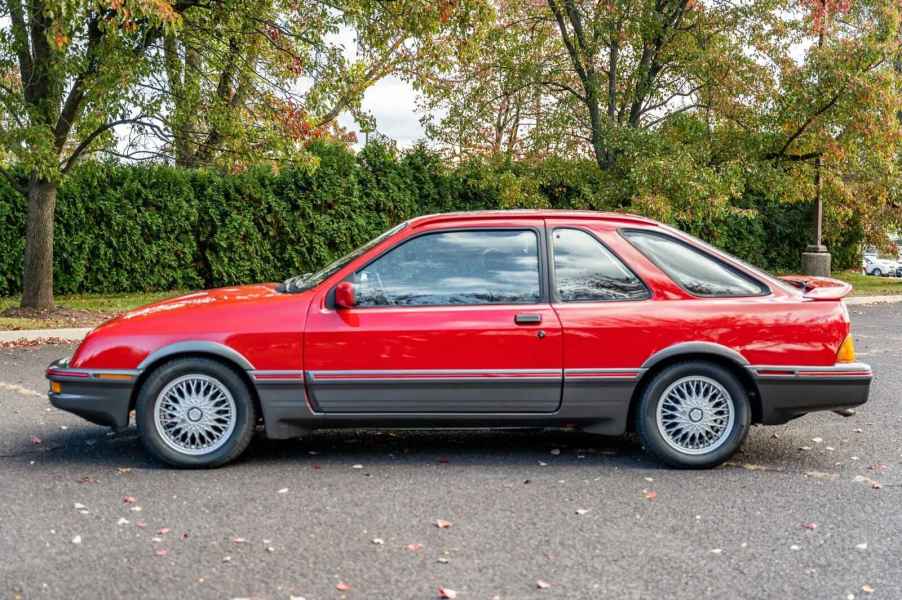
5 Rad 80s and 90s Cars You Never Knew Existed
As much as we like to report on new cars and all the latest and greatest features, they sure don’t make them like they used to. No, we’re not going to rant about how great the cars from the 50s were. Actually, we’re going to talk about how great the cars from the 80s and 90s were. But they were great in a different way, and dare we say, “totally rad.” As such, here are five totally rad cars from the 80s and 90s that you probably never knew existed.
Merkur XR4Ti
If you’ve never heard of the brand Merkur, we don’t blame you. As the story goes, Ford of Europe wanted to bring the Ford Sierra XR4i, a European hot hatchback, over to the U.S. But rather than rebadging it as a Lincoln or Mercury, Ford rebadged it as a “Merkur,” which is the German word for “Mercury.” The new name was meant to draw in buyers who were looking for something more upscale, and the car itself was meant to take on the BMW 3 Series.
However, the car’s funky looks and weird name didn’t win buyers over and it only lasted from 1985 to 1989, as the XR4Ti died out with the rest of the brand. In case you’re wondering, this little hatchback was powered by a 2.3-liter turbocharged, four-cylinder that produced 175 horsepower and 200 lb-ft of torque, which may have been related to the current Mustang Ecoboost engine.

Mitsubishi Cordia
Do you remember the Mitsubishi Starion? No? Well, the Mitsubishi Cordia was the Starion’s smaller sibling and was meant to take on the Toyota AE86 and the Volkswagen Scirocco at the time. The Cordia was produced from 1982 to 1990 and was one of the first Mitsubishis sold in the U.S. without the assistance of Daimler Chrysler. Unfortunately, it didn’t catch on, and Mitsubishi didn’t sell many in the States; however, it did well in other countries.
The odd-shaped hatchback was powered by either a 1.6-liter naturally aspirated engine or a turbocharged 1.6-liter engine that produced 116 horsepower. What was really interesting was that the base engine was available with an eight-speed Super Shift manual transmission, which had four “high” gears and four “low” gears, one set for “power” and the other for better fuel economy.

Isuzu VehiCROSS
The Isuzu VehiCROSS is as much of a head-turner now as it was back in 1999 when it debuted. The oddly shaped, two-door SUV was only in production for two model years, but contrary to popular belief, it wasn’t a sales flop. In fact, Isuzu only intended to have a limited-production run of the VehiCross, and its success was not only attributed to its futuristic look but also its off-road capability thanks to a 215-hp V6 engine and its Torque-on-Demand 4×4 system. Sadly, the VehiCross was discontinued in 2001.

Suzuki X-90
What do you get when you mate a car, a truck, and a compact SUV into one tiny package? You get a Suzuki X-90. This “mini ute” was quite the oddity when it came out in 1995 and on top of that, it only had two seats and produced a whopping 95 horsepower, although it did come in an all-wheel-drive configuration. Other than the fact the X-90 could not be categorized into a single automotive segment, buyers found better value in rivals like the Honda CR-V and Toyota RAV4 at the time as they could fit more than two occupants and were in the same price category. Needless to say, the Suzuki X-90 was discontinued after two years.

Subaru XT6
The Subaru XT was a two-door coupe sold from 1985 to 1991 and was the epitome of 80s sports car styling. Its wedge-shape and boxy dimensions looked more like automotive origami; however, they were functional, as the XT was one of the most aerodynamic Subarus ever built. The XT6 was the performance variant, which had a 2.7-liter flat-six engine under the hood, as well as a stiffer suspension and speed-variant power steering setup.

These cars were totally rad
While we can’t say we miss some of the odd exterior styles of cars from the 80s and 90s, we can definitely be appreciative that they gave way to the cars that we know and love today. And while automakers don’t quite make cars the same way they did back then, one sure thing is that cars back then were totally rad.
This article was originally published on July 1, 2020, and was updated for freshness on June 5, 2024.



